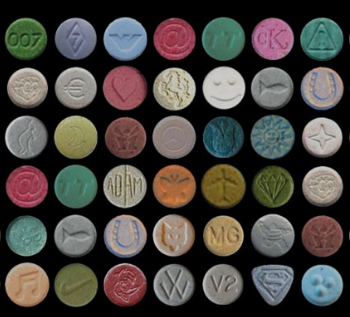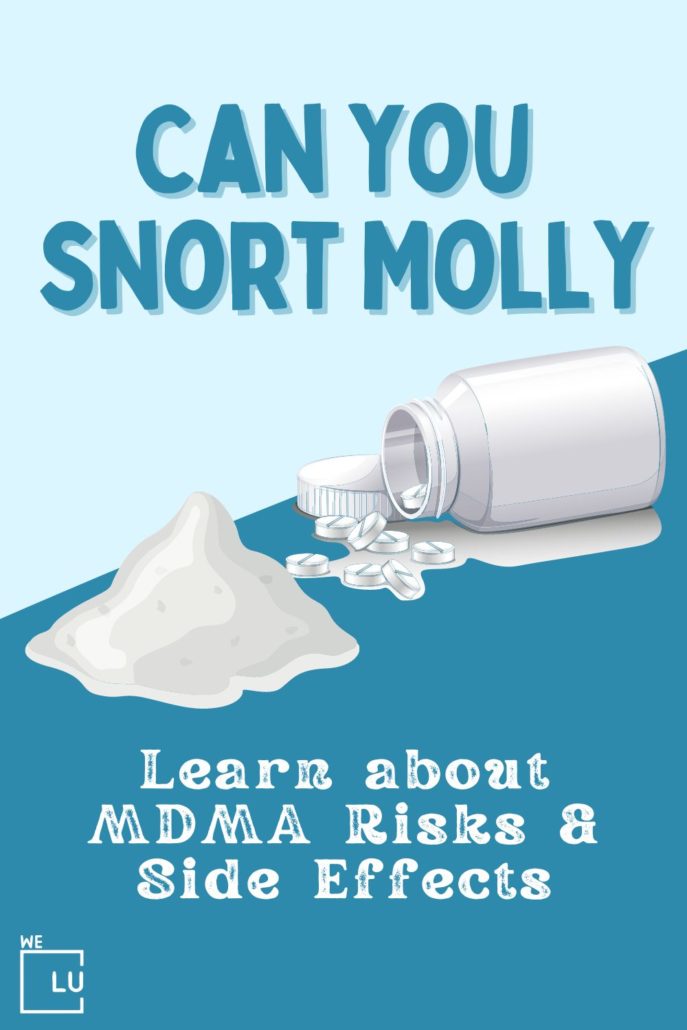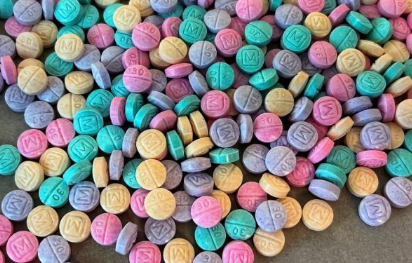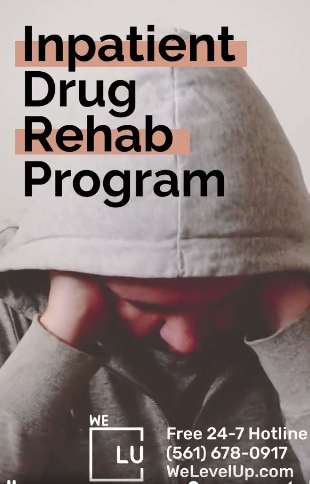Is Molly Addictive? Symptoms and Risks of Molly Addiction
“Molly” is a street name for the synthetic drug 3,4-methylenedioxy-methamphetamine (MDMA). The party drug, also known as “Ecstasy”, is an illegal substance commonly taken for its prosocial effects, including increased feelings of empathy and pleasure. Molly is a synthetic drug that alters your mood and perception. Chemically, it’s similar to stimulants and hallucinogens and produces effects such as:
- Enhanced energy levels
- Increased feelings of pleasure
- Emotional warmth
- Distortions in sensory and time perception
Is MDMA addictive? Molly/MDMA is an illegal substance in the U.S. It is a popular party drug, and it can come in tablet, capsule, powder, and liquid forms. The National Institute on Drug Abuse (NIDA) reports that the negative side effects of Molly include:
- Involuntary teeth clenching
- Nausea
- Muscle cramps
- Blurred vision
- Chills
- Sweating
Can you get addicted to molly? Molly triggers the overproduction of serotonin. It can cause the brain to later become critically short on the chemical, producing negative psychological effects in the days following its use. These negative after effects of molly can include:
- Poor memory
- Depressed feelings
- Confusion
- Anxiety
- Paranoia
- Attention disturbances
Molly is rarely “pure”. It often contains other substances that can result in dangerous drug interactions. High doses of Molly / excstacy pills can also cause your body temperature to spike, which can subsequently result in serious damage to the liver, kidney, and heart—and even sudden death.
Causes of Molly Addiction
Individuals who are addicted to molly have reported symptoms of Molly / MDMA addiction, including continued use despite negative physical or psychological consequences, tolerance, craving, and withdrawal. Molly withdrawal symptoms can include:
- Fatigue
- Appetite loss
- Depression
- Concentration problems
Data implies that MDMA use produces adaptations in the serotonin and dopamine systems that are associated with substance use disorder and related behaviors.
There are differences between tolerance, dependence, and addiction to molly. How the brain and body react to the drug is key. Some individuals develop a tolerance to drugs. With tolerance, the person needs to use more of the drug or use it more often to get the same effects as when they first started taking molly. This is sometimes why people take more molly or ecstasy over time.
When the body becomes dependent on a drug like molly, you can have physical and emotional symptoms, or withdrawal symptoms, from the drug if you stop using it. A substance use disorder involves dependence as well as a complex brain-reward system. The neurotransmitter dopamine plays a major role. In some individuals, it also creates strong cravings for the drug.
This can have serious effects on the brain and body. Use of the drug becomes compulsive even when it causes harm, like experiencing poor health or losing relationships or jobs. There are also genetic, environmental, and social aspects to substance use disorders.
Molly Interactions & Dangers
The risk of experiencing adverse molly side effects and even death increases significantly when combining multiple substances over a short period of time. When mixing molly and alcohol, for example, the risk of alcohol poisoning increases because the stimulant masks feelings of intoxication, so users tend to drink far more than they normally would.
When combined with alcohol, the pleasurable feelings that Molly provokes may feel a little stronger at first. However, users will typically experience a crash once the effect of the neurotransmitters wears off, and that crash often includes depression, anxiety, and trouble sleeping.
High doses of Molly may also affect the body’s ability to control its own temperature. This can cause overheating that could result in liver, kidney, or heart failure, or death.
Get Help. Get Better. Get Your Life Back.
Searching for Accredited Drug & Alcohol Rehab Centers Near You? Or Mental Health Support?
Even if you have failed previously, relapsed, or are in a difficult crisis, we stand ready to support you. Our trusted behavioral health specialists will not give up on you. Call us when you feel ready or want someone to speak to about therapy alternatives to change your life. Even if we cannot assist you, we will lead you wherever you can get support. There is no obligation. Call our hotline today.
FREE Addiction Hotline – Call 24/7Molly Addiction Statistics
The thought of over twenty thousand Molly users near death’s door being hauled in by ambulances is certainly troubling. People on psychoactive drugs often come to the hospital because they think something might be wrong; they get scared. With molly, a lot of ‘got scared’ stories appear to be happening. Numbers alone don’t really tell the whole story, however: Where things get interesting is not how many users encounter medical problems, but why they do. The distribution of injuries and deaths is not random throughout the user population; it is associated with specific risk factors and behaviors.
10%
Over ten percent of seniors in high school have used Molly at least once.
Source: NIH
2.6 million
In 2020, 0.9% (or over 2.6 million) of those 12 and older reported using Molly (Ecstasy) in the previous 12 months.
Source: NIH
1.1%
A projected 0.6% of eighth-graders, 0.7% of tenth graders, and 1.1% of twelve-year-old reported using Molly in the previous year in 2021.
Source: NIH
Molly Drug Fact Sheet
What is Molly / MDMA / Ecstasy?
Molly acts as both a stimulant and psychedelic,
producing an energizing effect, distortions in
time and perception, and enhanced enjoyment of
tactile experiences.
Adolescents and young adults use it to reduce
inhibitions and to promote euphoria, feelings of closeness, empathy, and sexuality.
What is its origin?
Molly is a synthetic chemical made in
labs. Seized MDMA in the U.S. is primarily
manufactured in, and smuggled across U.S.
borders from, clandestine laboratories in Canada
and, to a lesser extent, the Netherlands. A small
number of MDMA clandestine laboratories have
also been identified operating in the U.S.
What are common street names?
Common street names include:
- Adam
- Beans
- Clarity
- Disco Biscuit
- E
- Ecstasy
- Eve
- Go
- Hug Drug
- Lover’s Speed
- MDMA
- Peace
- STP
- X
- XTC
What does it look like?
Molly/MDMA/Ecstasy is mainly distributed in tablet form. MDMA tablets are often sold with logos, creating brand names for users to seek out. The colorful pills are often hidden among colorful candies. MDMA is also distributed in capsules, powder, and liquid forms.
How is it abused?
Molly use mainly involves swallowing tablets
(50-150 mg), which are sometimes crushed and
snorted, occasionally smoked, but rarely injected.
MDMA is also available as a powder.
Molly users usually take MDMA by “stacking”
(taking three or more tablets at once) or by
“piggy-backing” (taking a series of tablets over
a short period of time). One trend among young
adults is “candy flipping,” which is the co-abuse of
MDMA and LSD.
Molly/MDMA/Ecstasy considered a “party drug. As with many other drugs of abuse, MDMA is rarely use alone. It is common for users to mix MDMA with other substances, such as alcohol and marijuana.
What is its legal status in the United States?
MDMA/Molly/ Ecstasy is a Schedule I drug under the Controlled Substances Act, meaning it has a high potential for abuse, no currently accepted medical use in treatment in the United States, and a lack of accepted safety for use under medical
supervision.
Signs of Molly Addiction
The decision to stop taking Molly might be up to the individual, but family and friends can make it easier to quit by offering encouragement and support. First, they have to recognize and identify that there’s a problem.
- Unusually high levels of energy.
- Portraying abnormally friendly behaviors.
- Going out to party more than usual.
- Dilated pupils.
- Experiencing frequent and seemingly random exhaustion.
- Having trouble sleeping.
- Neglecting old friendships in favor of new ones.
- Lying, cheating, or stealing in order to obtain more Molly.
The most challenging part of helping a loved one with addiction may be recognizing that your loved one needs help. It may be hard for family members to spot the initial warning signs of ecstasy addiction, especially if their loved one is away at college, but eventually the signs will be impossible to hide.


Get Your Life Back
Find Hope & Recovery. Get Safe Comfortable Detox, Addiction Rehab & Mental Health Dual Diagnosis High-Quality Care at the We Level Up Treatment Centers Network.
Hotline (877) 378-4154The Short-Term Effects of Molly
The short-term effects of Molly may include:
- Distortion of light, sound, and touch
- Increased body temperature
- High blood pressure
- Rapid heart rate
- More energy
- Chills or sweating
- Muscle cramping
- Lowered inhibition
- Nausea
The Long-Term Effects of Molly
Some long-term effects of MDMA are more dangerous than others and may include
- Lingering confusion.
- Depression.
- Memory loss.
- Lack of focus or attention.
- Insomnia.
- Increased anxiety and impulsiveness.
- Low libido (or less interest in sex).
First-class Facilities & Amenities
World-class High-Quality Addiction & Mental Health Rehabilitation Treatment
Rehab Centers TourRenowned Addiction Centers. Serene Private Facilities. Inpatient rehab programs vary.
Addiction Helpline (877) 378-4154Proven recovery success experience, backed by a Team w/ History of:
15+
Years of Unified Experience
100s
5-Star Reviews Across Our Centers
10K
Recovery Success Stories Across Our Network
- Low Patient to Therapist Ratio
- Onsite Medical Detox Center
- Comprehensive Dual-Diagnosis Treatment
- Complimentary Family & Alumni Programs
- Coaching, Recovery & Personal Development Events
Molly Withdrawal Symptoms
The effects of Molly typically last 3-6 hours, but individuals may take a second dose as the effects of the initial dose fade or use the drug in a binge pattern, taking more than one dose back-to-back. After about a week of such use, Molly addict may experience issues such as irritability, impulsivity, sleep disturbances, anxiety, memory and attention problems, and a disinterest in sex. When molly use stops, some individuals, who repeatedly take the molly, report withdrawal symptoms, which may include:
- Fatigue
- Depression
- Difficulty concentrating
- Loss of appetite
- Sleep issues
- Anxiety
- Irritability

Causes of Ecstasy Withdrawal
Ecstasy artificially increases the activity of three of the brain’s chemical messengers—serotonin, dopamine, and norepinephrine. Serotonin is a neurotransmitter involved with mood regulation, appetite, sleep, and sexual arousal. Dopamine impacts energy and activity and is instrumental in rewarding or reinforcing pleasurable behaviors. Norepinephrine is important for a range of physiological functions, and an increase in its activity can lead to a rise in blood pressure and heart rate. In short, Ecstasy affects many of the same neurotransmitters in the brain that other known addictive substances target.
Generally speaking, stimulant withdrawal symptoms can start within 24 hours after last use and resolve over the course of the next 3-5 days. Factors that influence the length and intensity of ecstasy symptoms of withdrawal may include average amount or dose, frequency, and duration of ecstasy use. polysubstance use (using other substances such as marijuana and alcohol in conjunction with ecstasy) may extend and further complicate withdrawal and increase the individual’s risk for other harmful health effects. Co-occurring medical and mental health disorders can also influence the ecstasy withdrawal timeline as well as the character and severity of withdrawal effects
World-class, Accredited, 5-Star Reviewed, Effective Addiction & Mental Health Programs. Complete Behavioral Health Inpatient Rehab, Detox plus Co-occuring Disorders Therapy.
CALL (877) 378-4154End the Addiction Pain. End the Emotional Rollercoaster. Get Your Life Back. Start Drug, Alcohol & Dual Diagnosis Mental Health Treatment Now. Get Free No-obligation Guidance by Substance Abuse Specialists Who Understand Addiction & Mental Health Recovery & Know How to Help.
The Difference Between MDMA, Ecstasy and Molly
Ecstacy and Molly refer to the different forms of MDMA. MDMA, in its pure form, is either a white powder or crystallized.
What is MDMA?
MDMA is the official scientific name for this drug. “Molly” and “ecstasy” are both commonly used slang terms. However, since MDMA is currently illegal and therefore unregulated, anything sold as “molly” or “ecstasy” could range from being pure MDMA, to being cut with other drugs, to containing no MDMA at all. The molly market is one of the most adulterated illicit drug markets, meaning it often is cut with other substances.
What is Ecstasy?
Ecstasy was around longer than Molly and is most often recognized as a tablet of pressed powder. However, the powder in Ecstasy is mixed with other ingredients to help it keep its shape and sometimes reduce production costs. Is ecstasy addictive? Ultimately, yes, ecstasy can be addictive. While it is questionable whether individuals who abuse ecstasy develop physical dependence on the drug, repeated use of ecstasy can lead to a substance use disorder.
What is Molly?
Molly came later as a replacement for Ecstasy because of Ecstasy’s negative reputation for having mixed ingredients. It came from the word molecular and was thought to be purer because it did not require other components to hold it together as the tablet did. People use it in its original powder or crystal form, which they snort. Others use the powder in a capsule to ingest it. Less commonly, it is applied to blotting paper or used as an injection.
Molly is not as pure as people often assume. One news article reported findings by the DEA, which said only 13% of Molly seized in New York over the past four years contained any MDMA. Other drugs often found in Molly are methylone, MDPV, 4-MEC, 4MMC, pentedrone, and MePP.

Experience Transformative Recovery at the We Level Up Treatment Center.
See our authentic success stories. Get inspired. Get the help you deserve.



Start a New Life
Begin with a free call to an addiction & behavioral health treatment advisor. Learn more about our dual-diagnosis programs. The We Level Up treatment center network delivers various recovery programs at each treatment facility. Call to learn more.
- Personalized Care
- Caring Accountable Staff
- World-class Amenities
- Licensed & Accredited
- Renowned w/ 5-Star Reviews
We’ll Call You
Molly Addiction Treatment
First and foremost, if you think a loved one is abusing molly, you should research the substances and their associated addiction to understand better what your loved one needs. Next, you must plan an intervention to provide your loved ones with options to battle the effects of molly addiction in a safe and supportive environment. During this intervention, offer compassion and support instead of judgment. Lastly, show your support throughout the entire treatment process.
In addition, prolonged drug use can have severe physical and psychological effects on you, so it is essential to seek treatment as soon as possible. Inpatient drug rehab offers intensive care that can help you promptly get through the early stages of withdrawal.
Molly Detox
Medical detox is often considered the first stage of treatment. It will help you navigate the complicated withdrawal symptoms but doesn’t address patterns of thought and behavior contributing to drug use. Various treatment approaches and settings can help provide the ongoing support necessary to maintain long-term sobriety after you complete the molly detox.
Cravings are very common during drug detox and can be challenging to overcome. This often leads to relapse. Constant medical care provided during inpatient treatment helps prevent relapse. Clinicians can give medication and medical expertise to lessen cravings and molly symptoms of withdrawal.
Inpatient Molly Addiction Rehab
There isn’t one treatment approach or style that will suit everyone. Treatment should speak to the needs of the individual. Inpatient rehab and addiction treatment aren’t just about drug use. the goal is to help the patient stop using molly and other substances, but drug rehab should also focus on the whole person’s needs.
Addiction is a complex but treatable disease that affects brain function and behavior. When someone or their family is considering different treatment facilities, they should account for the complexity of addiction and the needs of the individual. The objective of attending an inpatient rehab center for addiction treatment is to stop using the drug and re-learn how to live a productive life without it.
Following a full medical detox, most people benefit from inpatient rehab. Inpatient drug rehab can last anywhere from 28 days to several months. Patients stay overnight in the rehab facility and participate in intensive treatment programs and therapy. Once someone completes rehab, their addiction treatment team will create an aftercare plan, which may include continuing therapy and participation in a 12-step program like Narcotics Anonymous.
Psychotherapy
Many rehab programs will also have early morning classes or programs. Group sessions occur during inpatient rehab, as do individual therapy sessions. Family therapy may be part of inpatient rehab when it’s feasible. Alternative forms of therapy may be introduced during inpatient rehab, like a holistic therapy program, yoga for addiction recovery, or an addiction treatment massage therapy.
Several different modalities of psychotherapy have been used in the treatment of mental health disorders along with addiction, including:
- Cognitive Behavioral Therapy (CBT) – is an effective treatment that involves changing both the patterns of negative thoughts and the behavioral routines which are affecting the daily life of the depressed person for various forms of depression.
- Dialectical Behavioral Therapy – is a comprehensive mental health and substance abuse treatment program whose ultimate goal is to aid patients in their efforts to build a life worth living. The main goal of DBT is to help a person develop what is referred to as a “clear mind.”
- Solution-focused therapy is an approach interested in solutions that can be quickly implemented with a simple first step leading to further positive consequences.

Dual Diagnosis Treatment
Drug abuse and mental health disorders often co-occur. Traumatic experiences can often result in mental health disorders and substance abuse. Dual-diagnosis rehabilitation treats both of these issues together. The best approach for the treatment of dual diagnosis is an integrated system. This strategy treats both the substance abuse problem and the mental disorder simultaneously. Regardless of which diagnosis (mental health or substance abuse problem) came first, long-term recovery will depend mainly on the treatment for both diseases done by the same team or provider.
Molly Addiction Rehab Near Me
Please, do not try to detox on your own. The detox process can be painful and difficult without medical assistance. However, getting through the detox process is crucial for continued treatment. We Level Up provide proper care with round-the-clock medical staff to assist your recovery through our opioid addiction treatment program medically. So, reclaim your life, and call us to speak with one of our treatment specialists. Our counselors know what you are going through and will answer any of your questions.
Molly addiction is a condition that can cause major health problems, such as an overdose. We Level Up NJ rehab treatment & detox center can provide you, or someone you love, the tools to recover from this with professional and safe treatment. Feel free to call us to speak with one of our counselors. We can inform you about this condition and clarify issues like withdrawal symptoms. Our specialists know what you are going through. Please know that each call is private and confidential.
Search We Level Up NJ “Is Molly Addictive?” Topics & Resources
Sources
[1] MDMA (Ecstasy/Molly) DrugFacts | National Institute on Drug Abuse (NIDA) (nih.gov)
[2] Controlled Substances by CSA Schedule (usdoj.gov)
[5] Drug Fact Sheet: Ecstasy/MDMA (dea.gov)
[6] MDMA Use and Death Rate Statistics | The DEA: The definitive guide to MDMA (molly, ecstasy)
[7] MDMA and the Brain: A Short Review on the Role of Neurotransmitters in Neurotoxicity – PMC (nih.gov)
[8] 3,4-Methylenedioxy-Methamphetamine Toxicity – StatPearls – NCBI Bookshelf (nih.gov)
[9] The pharmacology and toxicology of “ecstasy” (MDMA) and related drugs – PMC (nih.gov)